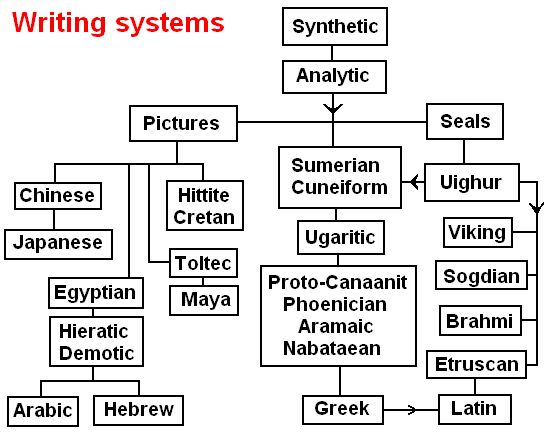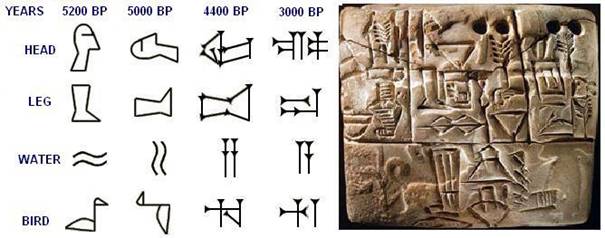|
There
is a lot of research done on the evolution of writing systems.
It is in general accepted that the Chinese and Sumerian
scripts developed independently as the first writing systems.
But these systems are only the end product of thousands of
years of human evolution. By evolution, I do not mean the
physical, Darwinian type evolution, but rather the evolution
of the social life as a result of the diversification of goods
and tools. Below the interrelationship of writing systems can
be seen. The first synthetic writing system was the early cave
paintings and petroglyphs seen allover the world. The messages
in these figures can be understood only if the beliefs and
expectations of these cultures are known. Several examples of
petroglyphs have been given in the previous chapters.
Early
writing systems were semiotic and synthetic. As time went by
analytic writing started. By analytic I mean that a word or
part of a word (a syllable) is represented by a well defined
sign.

Synthetic writing developed into analytic writing when the
pictures transformed into simplified seals. The above Table
cannot be found in any standard textbook. This is because the
seal-based form of expression and communication, specific to
nomadic Uighur tribes, has not been considered as a writing
system by linguistic scholars. The picture-based writing
system is known as “Pictographic”, but no name exists for the
seal-based writing system. The seal-based system started in
Asia, with the need to mark the herd animals of nomadic
tribes. This was a way for identifying animals when two herds
occupied a common pasture. The seals were stylized and
simplified forms of the petroglyphs and in time started to
represent monosyllabic root words. This is how the Uighur
(Turkic) runic syllabary came into being.
The
Sumerian people, who came to Mesopotamia from Asia, started to
make marks on soft clay, which came to be known as the
Cuneiform writing system. The early cuneiforms were
representations of root words. Since each form was a full word
the script was recognized as being “logographic. Below some
examples are shown. We can see how the simple Sumerian
pictographic writing system transformed into the complicated
system of Assyrians and Babylonians. On the right we see an
original Sumerian clay tablet.

The same
transformation from simple to complicated forms happened
within the Chinese script. Three examples can be seen below.

It can
happen that several different styles of writing have or even
are still being used by some cultures. In the ancient times
the Hittites used both the cuneiform Sumerian system and also
their own pictographic (hieroglyphic) system in parallel. The
cuneiform influence came through the Ugaritic script. The
pictographic script system is known as
the Hittite hieroglyphs.
An example will be discussed in the next chapter.
Today
the Japanese people write in four different scripts. These are
Kanji, Hiragana, Katakana, and Romanji. Kanji is the
logographic Chinese script which has more than 50,000
characters. There are 46 Hiragana and 46 Katakana characters
which are phonetic in nature. They are symbols representing
syllables. The Katakana script is used to write loan words
that cannot be represented in Kanji. The Romanji script is
what Japanese call the Latin alphabet. In modern Japanese
texts one can find a mixture of all these four writing
systems.
In the
Table at the top we can see that the Egyptian hieroglyphic
system became simplified to first Hieratic and then to Demotic
writing system. These scripts had their influence on several
alphabetical scripts, such as Arabic and Hebrew. The Latin
alphabet is the offspring of both Greek and Etruscan but it is
also influenced, through Phoenician, by the Sumerian
cuneiforms. All these interrelationships will be discussed and
explained in the future chapters. |